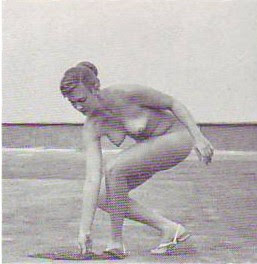 Here, so far as I can tell, is the origin of the modern comic strip. Caveat: take this with a grain of salt; I'm no expert on the subject and I might have over-simplified things.
Here, so far as I can tell, is the origin of the modern comic strip. Caveat: take this with a grain of salt; I'm no expert on the subject and I might have over-simplified things.Well, you could argue that it all began with Daumier (example above). Sure there was Hogarth, Cruikshank and others but Daumier was different. His lithographs weren't just beautiful and funny, they retained the fluid feel of the original sketches. Not only that but Daumier was a famous easel painter and that bought a lot of credibility for his cartoons. Cartooning was considered a low-class activity in Daumier's time and his fine art reputation did a lot to make it acceptable to the middle class.
 Success always breeds imitators and Daumier's imitator was a guy named Cham (example above). Cham got his foot in the door by offering simplified Daumier-style drawings in a series for the same price that Daumier got for just one picture. Cham might have been a weasel but he did help to popularize the idea that cartoons should tell a story using multiple pictures.
Success always breeds imitators and Daumier's imitator was a guy named Cham (example above). Cham got his foot in the door by offering simplified Daumier-style drawings in a series for the same price that Daumier got for just one picture. Cham might have been a weasel but he did help to popularize the idea that cartoons should tell a story using multiple pictures. Cham was so successful that he inspired a German named Rodolphe Topffler to try his hand. Topffler used Cham's serial panel technique but drew the characters in what he called the "outline method," a technique that didn't require Daumier's painterly tones and shadows. I don't know if Topffler was an aristocrat but he seemed to want the public to think that he was. His outline method was executed in a deliberately crude style so that it would appear that he just dashed them out for his own amusement and had no thought of making money with them.
Cham was so successful that he inspired a German named Rodolphe Topffler to try his hand. Topffler used Cham's serial panel technique but drew the characters in what he called the "outline method," a technique that didn't require Daumier's painterly tones and shadows. I don't know if Topffler was an aristocrat but he seemed to want the public to think that he was. His outline method was executed in a deliberately crude style so that it would appear that he just dashed them out for his own amusement and had no thought of making money with them. Back in France, Dore saw what Topffler was doing and approved, only he thought the outline method worked better if the characters were a bit more realistic and were carefully inked. Dore wasn't very fond of the serial picture method. He preferred big, Jack Davis-type crowd scenes like the one above.
Back in France, Dore saw what Topffler was doing and approved, only he thought the outline method worked better if the characters were a bit more realistic and were carefully inked. Dore wasn't very fond of the serial picture method. He preferred big, Jack Davis-type crowd scenes like the one above. Back in Germany Wilhelm Busch (example above) combined the best ideas of all the artists I just mentioned: Daumier's belief that cartoons could be fine art, Cham's multiple panel idea, Topffler's outline technique and Dore's clean-up theories. Busch was the first artist to make a good living exclusively by doing funny panel cartoons. People say he was the first truly modern master of the comic strip. After him comes the great German-American newspaper artists like Dirks, the creator of "The Katzenjammer Kids." You know the rest.
Back in Germany Wilhelm Busch (example above) combined the best ideas of all the artists I just mentioned: Daumier's belief that cartoons could be fine art, Cham's multiple panel idea, Topffler's outline technique and Dore's clean-up theories. Busch was the first artist to make a good living exclusively by doing funny panel cartoons. People say he was the first truly modern master of the comic strip. After him comes the great German-American newspaper artists like Dirks, the creator of "The Katzenjammer Kids." You know the rest.
A few questions remain. Where were the English while all this was going on? Why did the creative torch pass to the United States? Who invented the modern version of the word balloon?
















































